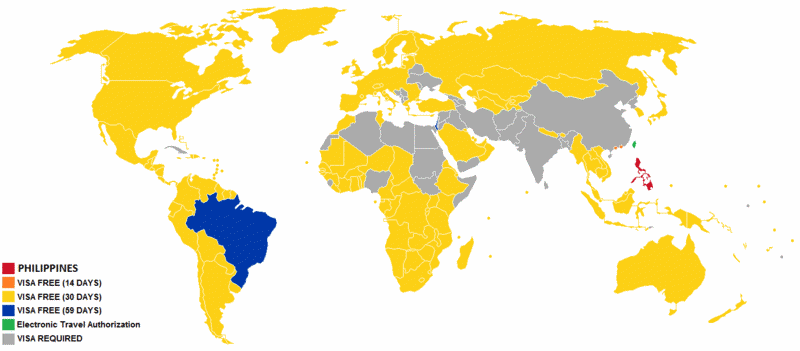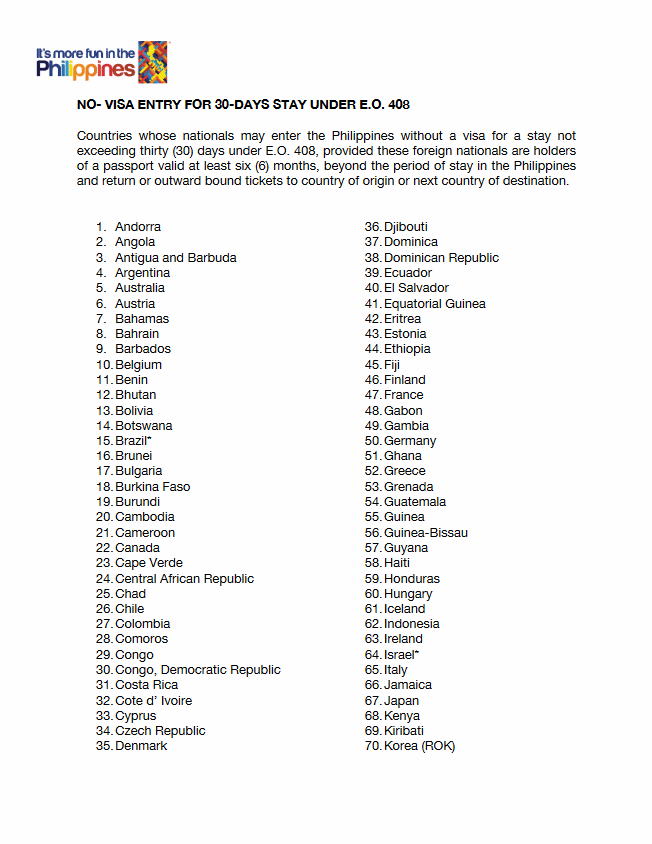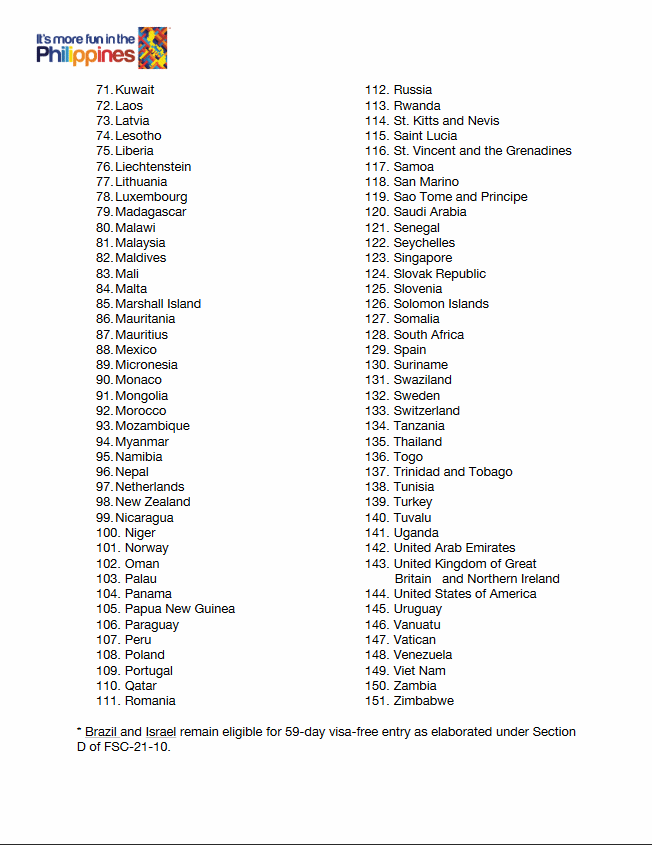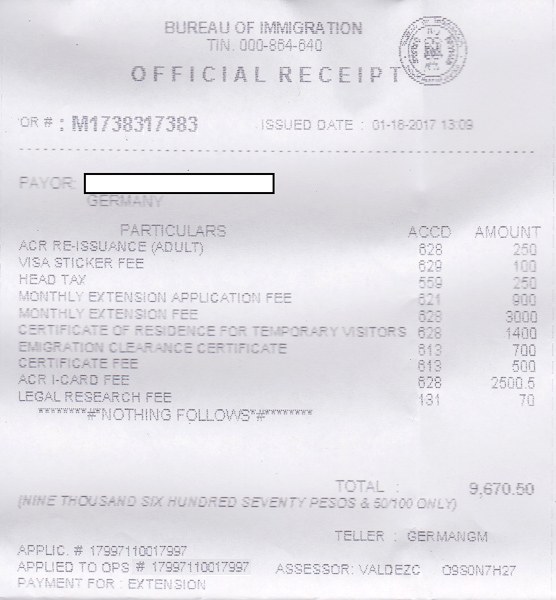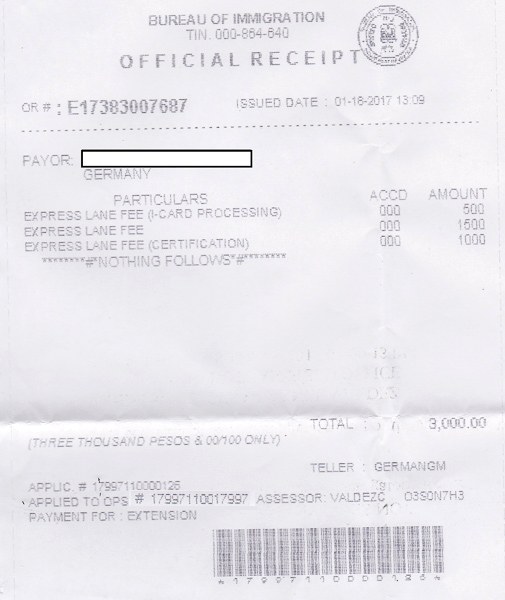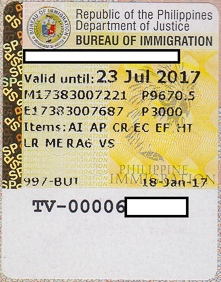Visa Philippines
Tourist Visa & Resident Visa
IMPORTANT!
Philippines Visa
Nationals of over 150 countries do not need a visa to visit the Philippines. On arrival they receive a free Visa Waiver.
Tourists can now stay 30 days for free with this Visa Waiver. It is given to them at the immigration desk in ports and airports.
The extension of the Visa Waiver for another 29 days costs PHP 3,130.00.
Visa and Visa Waiver can be extended at any office of the Bureau of Immigration. See also here Procedures for foreigners
When we started "Silent Gardens" ten years ago, the website of the Bureau of Immigration had been just a collection of documents. In the last years this website became a real source of almost up to date information. We strongly recommend to read this legal source.
Expatriates can escape from Visa-Run, Annual Report and Emigration Clearance Certificate with an SRRV.
Beware of overstay and visa violations.
The Bureau of Immigration can be very strict in interpreting the laws. Visa violations and overstay often result in hefty penalties, prison and deportation.
Visa procedures
People from most European countries and the USA can enter the Philippines without a Visa and will be granted an entry permit (called a visa waiver) for 30 days. This permit may be extended at any Immigration Office in the Philippines for another 29 days and thereafter every two months for up to 16 months in total. Please read the section about Visa Extension for more details.
Countries with special regulations are: Afghanistan, Algeria, China, Egypt, India, Iran, Iraq, Libya, Lebanon, Jordan, Nigeria, Pakistan, India, Sudan, Syria, Palestine, Yemen, Taiwan, Hongkong, Macau, East Timor.
The Bureau of Immigration reminds foreigners that possession of a Philippine entry visa is not a guarantee that its holder will be automatically admitted into the country. Read more here ...
Philippines Embassies abroad are also issuing different kinds of Tourist Visa (e.g. the 9A) for the Philippines:
Two Philippines arrival stamps

The stamp shows the arrival date, the flight number and the date of expire of the visa-waiver. If you have a visa from an embassy abroad with more than 30 days of stay, please verify the expiry date on the stamp. corresponds to the duration of the visa. Often the immigration officers do not change the date on their stamp and so does not corresponds to the duration of the visa.
A Philippines departure stamp

The stamp shows the departure date and the flight number. If you plan to come back to the Philippines, make sure that the stamp is readable. You will need the stamp's date on your next arrival.
59 days Tourist Visa, 1 entry: EUR 27.00
3 months Tourist Visa, 1 entry: EUR 39.00
6 months Tourist Visa, multiple entry: EUR 78.00
12 months tourist Visa, multiple entry: EUR 117.00
Prices for Visas are taken from the Philippine Embassy in Germany but should be similar in all other countries.
In Norway the following visa fees apply:
Single ENTRY valid for three (3) months NOK 210.00Multiple ENTRY valid for six (6) months NOK 420.00
Multiple ENTRY valid for one (1) year NOK 630.00
If you are married to a Filipino citizen, you may ask for a Balikbayan Stamp in your passport at the Immigration point where you want to enter the Philippines. A Balik Bayan stamp is good for 1 year and is free of charge. You have to bring you marriage certificate in English, your Filipino Spouse and you have to ask the Immigration Officer for it. Please read under Balikbayan Stamp for more details!
Also, if you are legally married to a Filipino/Filipina you may apply for a Permanent Resident Visa 13A for the Philippines, as stated in the Philippine Immigration Act of 1940, Section 13. Details are here: Resident Visa
If you are already retired and/or at least 35 years old, you may also apply for a Special Resident Retirees Visa from the PRA ( Philippine Retirement Authority). This Visa is not only for retirees, but also for investors and other people who just want to live in the Philippines and can prove their financial status.

An old 9a Tourist visa established in Geneva
Visa Extension
It seems that you now can extend your stay in the Philippines for up to 36 months without having to leave the country. But in the last months friends reported to us, that you are questioned when you have lots of extension stamps in your passport and that extensons above 16 months need additional information. We strongly recommend to read the visa pages of the Bureau of Immigration.
Most foreigners enter the Philippines without any Visa and they get a stamp, called a Visa Waiver, in their passports which is good for a 30 days stay. If someone wants to extend this stay, one would have to go the nearest Immigration Office and get the extension good for another 29 days. The cost for this first extension is 3,030 Pesos.
When you are already 59 days in the Philippines and want to stay a bit longer, then your regular extension series starts. You have to show up at an office of the Bureau of Immigration a couple of days before your Visa Waiver expires. You may also do it at an accrdited Travel Agency. The list is here.
If you have to go to the Immigration Office, make sure to wear long pants, a nice shirt and shoes. Otherwise you might not be serviced, some Immigration offices (Cebu) might not even let you in.
The Extensions Sequence
Enter the Philippines without a Visa:
30 days for free
Or, come now - pay later!
*Fees are updated as of 06 March 2014 and may change without prior notice. (Official text from BI). We have ammended with current information sent by readers.
IMPORTANT: When you extend your visa keep the receipt from the BI office. You'll need it for your next extension and for your ECC. Without receipt no ECC! See also here.
1st extension:
Visa Waiver for another 29 Days:| Visa Waiver | PHP 500.00 |
| Visa Application Fee | PHP 1,000.00 |
| Certification Fee | PHP 500.00 |
| Express fee Processing | PHP 1,000.00 |
| Legal Research Fee | PHP 30.00 |
| Visa Sticker Fee | PHP 100.00 |
| Total | PHP 3,130.00 |
The old extension stamp
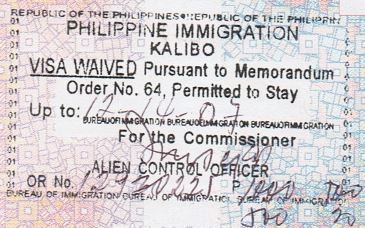
The last extension stickers
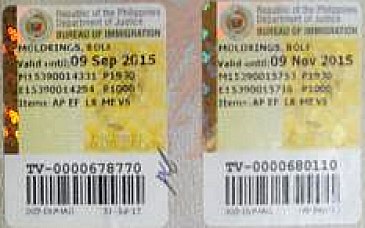
And a new fee ... 100 pesos only!
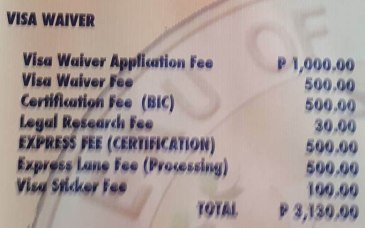
Newest change: There ar no more extension stamps or stickers.
You have to keep the receipt of your last extension. Do not loose it!
IMPORTANT: You can only get two 6 months extensions within the allowed maximum of 36 months. (We have been informed that some field offices of the BI allow more than 2 six months extensions. This is hear-say information.) All other extensions are 2 months only. The first 6 months extension can only be obtained after the initial free 30 days and the following 29 days.
2nd extension:
After this 59 days you'll get a Tourist Visa and an ACR-I card. Read more information about the ACR Card.
Standard validity of the visa extension is 2 months, but you now can get 1 month or 6 months also.
The 2 months extension costs:
| Visa extension fee | PHP 1,000.00 |
| Visa Application Fee | PHP 300.00 |
| Alien Certificate of Registration | PHP 1,000.00 |
| Head Tax | PHP 250.00 |
| Certification Fee | PHP 500.00 |
| Express Fee | PHP 1,000.00 |
| Emigration Clearance Certificate Fee | PHP 700.00 |
| Legal Research Fee | PHP 50.00 |
| Visa Sticker Fee | PHP 100.00 |
| Total | PHP 4,900.00 |
| Additional costs for ACR-I card: | |
| ACR I-Card for Tourist USD 50.00 | ˜ PHP 2,500.00 |
| Express Fee | PHP 500.00 |
| Total | PHP 3,000.00 |
| Grand Total | PHP 7,900.00 |
1 month extension costs PHP 7,400.00
6 months extension costs PHP 12,670.50
3rd extension:
Next extension for 2 months
| Visa Extension Fee | PHP 1,000.00 |
| Visa Application Fee | PHP 600.00 |
| Certification Fee | PHP 500.00 |
| Express fee Processing | PHP 1,500.00 |
| Legal Research Fee | PHP 30.00 |
| Visa Sticker Fee | PHP 100.00 |
| Total | PHP 3,730.00 |
By now you are already 6 months in the Philippines and you have spent PHP 14,760.00 for visa fees, and it goes on:
4th extension:
Extension after 6 months for another two months
| Visa Extension Fee | PHP 1,000.00 |
| Certificate of Residence (temporary visitor) | PHP 1,400.00 |
| Visa Application Fee | PHP 300.00 |
| Certification Fee | PHP 500.00 |
| Express fee Processing | PHP 1,000.00 |
| Legal Research Fee | PHP 40.00 |
| Visa Sticker Fee | PHP 100.00 |
| Total | PHP 4,340.00 |
5th extension:
Next extension for another two months:
| Visa Extension Fee | PHP 1,000.00 |
| Visa Application Fee | PHP 300.00 |
| Certification Fee | PHP 500.00 |
| Express fee Processing | PHP 1,000.00 |
| Legal Research Fee | PHP 30.00 |
| Visa Sticker Fee | PHP 100.00 |
| Total | PHP 2,930.00 |
6th extension:
This last extension needs to be verified. The open question is the "Annual Report Fee".
Last extension for 2 months, to a total of 12 months:
| Visa Extension Fee | PHP 1,000.00 |
| Visa Application Fee | PHP 300.00 |
| Annual Report Fee ??? | (PHP 300.00) |
| Certification Fee | PHP 500.00 |
| Express Fee Certification ??? | (PHP 500.00) |
| Express Fee Processing | PHP 1,000.00 |
| Legal Research Fee | PHP 50.00 |
| Visa Sticker Fee | PHP 100.00 |
| Total | PHP 3,450.00 |
The total amount for one year's extensions is at least PHP 25,480.00 only! This is why expatriates often call the Philippines: Fee-lippines!
Consider two 6 months extensions if you stay for a year. This would cut your expenses.
Since 2015 you can extend your Visa for up to 36 month in total. After 16 month however you should make a Visa Run or try to get another extension for up to 24 months from the "Chef of the Immigration Bureau for Regulations". This might become too complicated, so it might be easier to make a Visa Run or to try to get a permanent resident visa.
Dresscode of the Bureau of Immigration
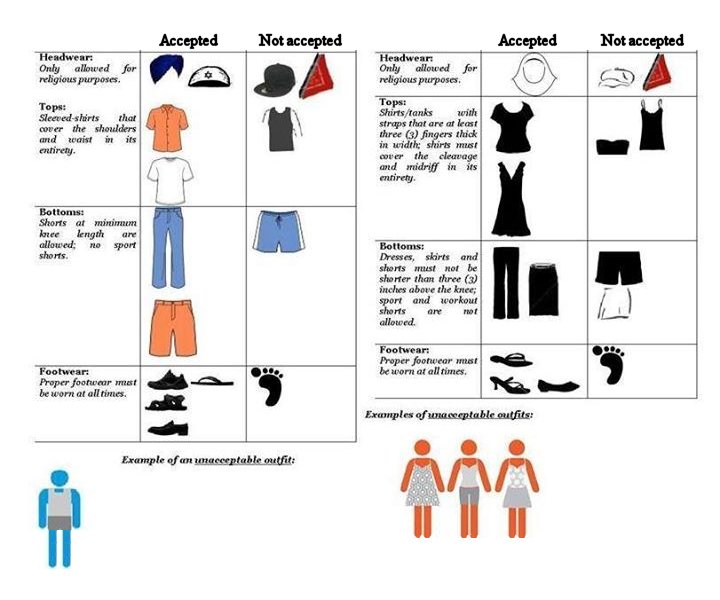
The Head Office of the Bureau of Immigration
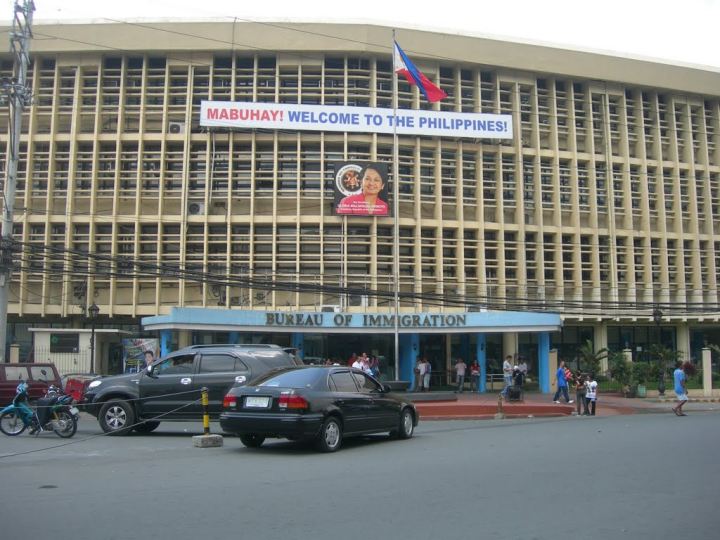
Bureau of Immigration - Head Office
Magallanes Drive, Intramuros, ManilaPhone: +632 527-3248
Toll Free: 1-800-100- ALIEN (24/7 Toll Free)
E-Mail: xinfo@immigration.gov.ph
Website: http://www.immigration.gov.ph
WARNING !
If you do not want to stay weeks or even months at the Bicutan Detention Center then you should really fully comply with the immigration law of the Philippines.
The Bureau of Immigration can be very strict in interpreting this law. Visa violations and overstay often result in prison and deportation.
"Café carré" the "resort" of the Bureau of Immigration Detention Center in Bicutan.

Bureau of Immigration Detention Center in Bicutan, Taguig, also called "Café carré"
WARNING AGAIN!
Currently the Bureau of Immigration runs a program of citizen awareness. Any Filipino or Filipina can send a text (SMS) to BI and denounce a foreigner suspect of illegal immigration or overstay.
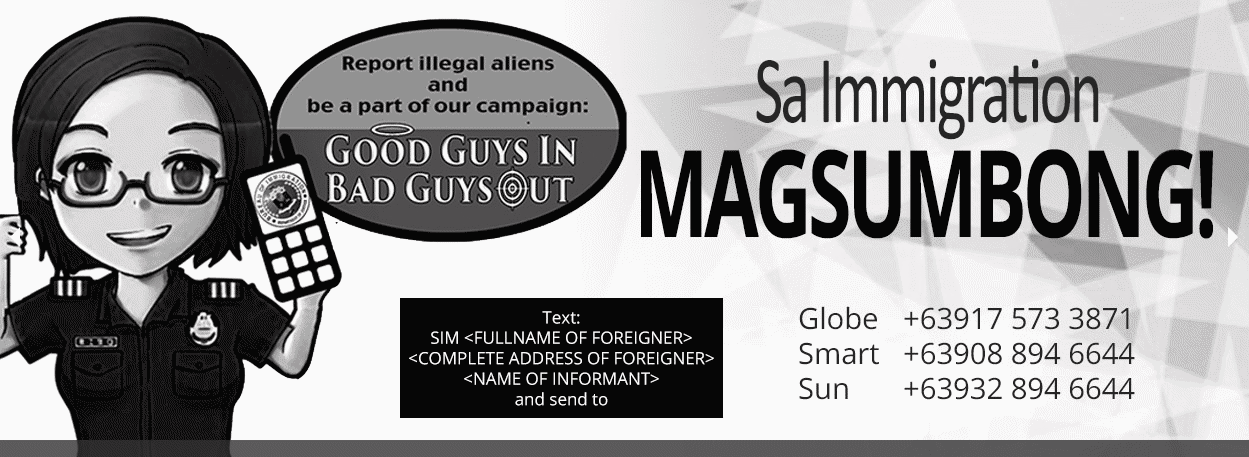
We recommend to fully comply with the immigration laws of the Philippines.

You won't like to see your picture (in the original it is clear) in press and on TV-screens.
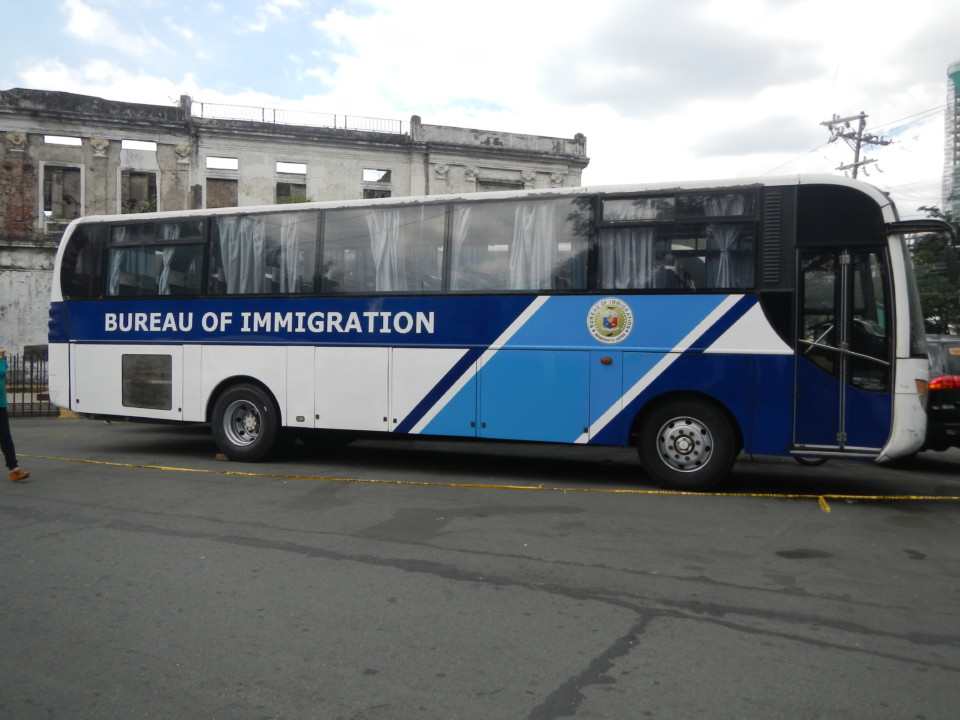
You better do not travel with this bus. It might be your last journey within the Philippines.
The Visa Run
Many expatriates who live in the Philippines with either an extended visa-waiver or a 9a tourist visa prefer to travel abroad for a day or two instead of paying a lot of money just for a stamp in the passport.
A good moment for a trip abroad is before the end of the 6th month and before the end of the first year.
As you know exactly when these expiry dates will be, you may book a promo flight already months before. Preferred "Visa Run" destinations are Kota Kinabalu, Bangkok and Hongkong.


Visa re-stamping
If a foreigner (alien) lives for a long time in the Philippines, one day his/her passport expires.
Most embassies can produce a new passport within 10 days to 2 weeks and send it to you by a courier service.
But your permanent resident visa, your Balikbayan stamp or your SRRV still sticks in the old passport.
The transfer of a visa from an old to a new passport is called "re-stamping" in the Philippines.
The procedure depends on your visa.
Any class 13 visa
You'll have to go to Manila. The re-stamping is only made in BI head office in Intramuros.
Here is the current form to fill in and to bring with your old and new passport.
The procedure will cost between PHP 1,010 and PHP 1,510
BI has invented a new "express fee: Simple or Double - Lovely Fee-lippines!
SRRV visa
Contact PRA. There is nothing about visa re-satmping to find on their website.
Their website is currently being overhauled.
But you can contact them on Client Relations
Leave them your phone number and your SRRV number. They call back within a day.
ACR-I Card
The Alien Certificate of Registration (ACR) I-Card is requested from any foreign person (called alien) who stays more than the 59 days. This means that tourists with a 9A visa are requested to have an ACR-I card issued, when they apply for a visa extension after the 38 days extension..
The ACR-I cards are only available in some offices of the Bureau of Immigration. Please inquire here!
Processing time is about 2 weeks! You will have to get your card at the BI.
The advantage of this ACR-I card is that you can open a bank account, register a car or a motorbike or even get a driver license without being a permanent resident.
The ACR I-Card is needed to get and the Emigration Clearance Certificate (ECC), and serves as Re-entry Permit (RP) and Special Return Certificate (SRC) of the holder upon payment of the required fees.
Since July 16, 2015 new ACR-I cards in different colors are issued. Long stay tourists (more than 59 days) get a white ACR-I card.
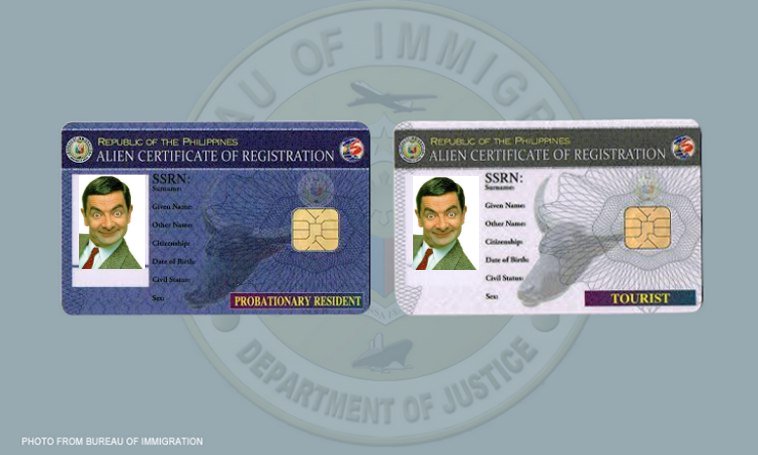
New ACR-I cards
Balikbayan Stamp
The easiest and (initially ;-) )the cheapest way to get a long term visa for the Philippines, is the Balikbayan Stamp in your Passport. This stamp is good for 1 year and can be extended at least once for another 6 months.
To get a Balikbayan Stamp in your Passport on arrival, you must be married to a Filipina/Filipino. You must present an English translation of your marriage certificate and your Filipina wife or Filipino husband must be together with you at the point of immigration.
Most important: You have to ask the Immigration officer for it, they won't give it to you automatically.
The immigration officer is not obliged to issue a Balikbayan Stamp even if you meet all the requirements. Nevertheless, it is rarely denied. The best of it: It's totally free of charge
The Balikbayan Stamp is available for direct relatives of Filipino citizens and former Filipinos who have changed their citizenship to another country.
If your Filipino husband or wife still has a valid Philippines Passport, he or she doesn't need a Visa or stamp in their Passports of course.
If you are legally married with a Philippines citizen, you may apply for the permanent Resident Visa (13A) as stated of the Philippine Immigration Act of 1940, Section 13. You must meet the following requirements:
- Notarized letter of application by the Filipino spouse
- Accomplished and Notarized General Application Form
- Copy of the birth certificate of the Filipino spouse, authenticated by the NSO
- Authenticated copy of the Marriage Contract by the NSO or Philippine Embassy abroad (if you got married abroad)
- Immigration Clearance
- Certified copy of the foreigners passport showing the date of arrival and Visa (Balikbayan Stamp)
- Certificate of a savings bank account with the minimum 10,000 US$ on it to prove, that you can financially support your family
- Pay about 20,000,- Pesos in total for fees (10,000 for application and another 10,000 for approval)
After the application is submitted, it may take several weeks or even month before you will finally receive your Resident Visa. After the first application, your Resident Visa will be granted for only one year.
After one year you'll have to submit another application but in a more simple way and the Visa then will be good for 10 years, before it needs to be extended again.
You can apply for the Resident Visa (13A) at the Immigration Offices in Manila, Cebu and Davao City. You may also ask for advice and help at any other Immigration Office in smaller cities in the Philippines.
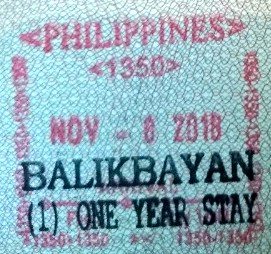
The Balikbayan stamp
The famous SRRV
Another way to get a permanent residence visa for the Philippines, is the Special Resident Retiree's Visa or SRRV . This Visa does not depend on whether you are married to a Filipino citizen or not, like the 13A Visa but it is based on a money deposit in a accredited bank in the Philippines.
The Philippines advertise this kind of visa with some advantages such as: Exemption from Customs Duties & Taxes for the importation of personal effects of up to USD 7,000.00, Exemption from Travel Tax, Exemption from the Exit Clearance and Re-Entry Permits, Exemption from the Immigration ACR-I Card, and from annual reporting. The holder of an SRRV has also the privilege to pass through the diplomatic channel at the immigration at the airport.
If you are interested in an SRRV, then we recommend to carefully read the website of the Philippine Retirement Authority (PRA).
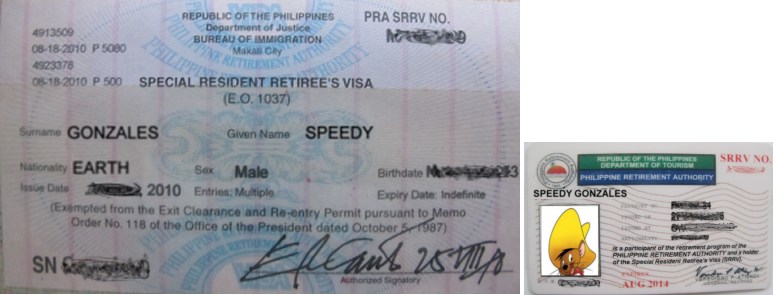
The famous SRRV and the corresponding ID
Emigration Clearance Certificate (ECC)
UPDATED:
Every foreigner who has been for more than 6 months in the Philippines, will need to get an Emigration Clearance Certificate (ECC) before leaving. The Bureau of Immigration recommends foreign nationals to process ECC three (3) days prior to the departure date. This way, if you have additional documents required or something needs to be done, you have at least 72 hours to process it.
The fee for ECC Clearance is around PHP 1,210 to PHP 3,000.
Those who have an SRRV are exempt of this certificate!
To get your Emigration Clearance Certificate (ECC), you have to bring:
- Application form;
- Photocopy of passport (bio page, visa pages, latest arrival);
- Original and photocopy of ACR I-Card;
- Photocopy of receipt of latest visa extension;
- Photocopy of order of downgrading (if applicable);
- Six pieces 2x2 photo
Here you can download the ECC Application Form.
The procedure (In Cebu-City you need 40 minutes):
- Go to the Reception Desk and tell the Immigration Officer sitting there that you need an Exit Clearance Certificate. She will ask to see your Passport and air ticket She will check to see if you have applied for all Extensions necessary for your stay. She will hand you a form to complete.
- You complete the form and return it to the same Receptionist and hand her your three photos. She will affix the photos to the form.
- You go to the "Cashier 3" window and hand in the form and your Passport. These will be checked and stamps are placed on the form; your Passport and form are handed back to you.
- You now go to "Cashier 1" and again hand over your Passport and Form. If you have a 9(a) Visa in your Passport (from a Philippines Embassy abroad) you will only pay an "Express Lane" fee of PHP500. If you don't have this Visa or if you have a Visa that grants residency (9(g), 13(a) etc), you'll pay considerably more (around PHP2900 + the PHP500 "Express Lane" fee). * You now sit and wait a few minutes before you will be called to be finger-printed. This takes place next to the "Cashier 1" window.
- After a few more minutes you'll be called and your Passport and ECC handed to you. That certificate you hand to the Immigration Officer just before boarding your international flight.

Waiting a very long time in the BI Head Office in Manila's Intramuros
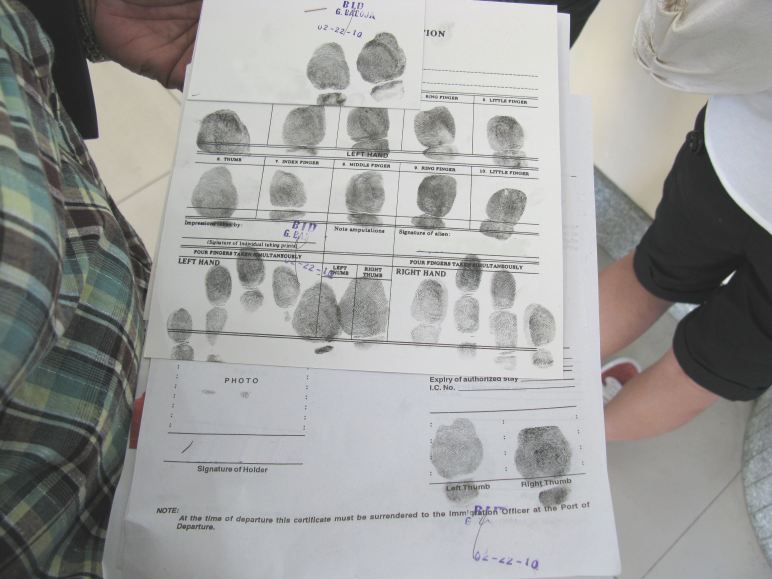
Fingerprints: A lot of ink and nothing to clean your fingers
BI field offices
You should also check the address list on the website of the Bureau of Immigration. Unfortunately none of the lists is up to date, neither theirs nor ours! Many phone numbers are cellphone numbers and many e-mail addresses are private 'gmail' or 'yahoo' addresses. If you want to help us, please inform us about address or phone number changes."
Luzon
Metro Manila
NAIA Terminal-1Arrival: 852-2936
Departure: 879-6085
NAIA Terminal-2
Arrival: 879-6018
Departure: 879-6017
NAIA Terminal-3
Arrival: 877-7888 loc. 8187
Departure: 877-7888 loc. 8128
BI CABANATUAN Satellite Office
City Hall Compound, Kapitan Pepe Subdivision
Cabanatuan City
Cell: 09163548685
BI STA. ROSA Satellite Office
Francisco Canicossa Ave. Balibago Complex
Sta. Rosa, Laguna
Phone.: (049)526-5786
Fax: (049)534-5205
Cell: (0917)897-5897
BI CAMANAVA Satellite Office
Caloocan Commercial Complex
Ground flr. Plaza, Rizal St. Cor. A. Mabini
Caloocan City
Phone: 288-8459
Cell: 0918-343 5534
BI TAYTAY RIZAL Satellite Office
Old Municipal Building, Taytay, Rizal
Fax - 658-7261
Cell: 0915 578 9199 /09178671519
BI MAKATI EXTENSION OFFICE
Third floor Lasala Bldg.
805 JP Rizal Avenue corner F. Zobel St., Makati
1210 Metro Manila
Phone: 899-3830; 899-3831 /899-2766; 897-5335
Cell: 092 284 12358
BI PEZA EXTENSION OFFICE
PEZA Building Ground Floor., Corner San Luis St.
Roxas Boulevard, Pasay City
Phone: 551-9590
Fax: 5519567
Cell: 0917 373 2357
BI PARANAQUE Satellite Office
Ground Floor Bldg. F., Great Mall of China
Bradco Avenue, Asiana Business Park, Paranaque City
Phone: 707-4859
Cell: 092 280 32061
Northern Luzon
BI Aparri Field Office2nd floor Melval Bldg. RF Balizi St.
Apparri, Cagayan
Phone: (078) 888-2089 or 2098
Fax: (078) 822-8288
BI Dagupan Field Office
People's Astrodome, Tapuac District
Dagupan City
Phone: (075) 523-4047
Cell: 0917 693 22 48
BI Baguio Field Office
#38 Military Cut Off, Baguio City
Phone: (074) 447-0805
Cell: 0918 916 0361
BI Santiago Field Office
2nd floor People's Coliseum
Santiago City, Isabela
Phone: (078) 682-2513
Cell: 0928 296 90 98
BI Tuguegarao Field Office
2nd floor Old City Hall Building
(Science High School)
Mabini Street
Tuguegarao City, Cagayan
Phone: (078) 844-9617
BI Laoag Field Office
Tupaz Avenue
Laoag City
Phone: (077) 770-4943
Fax: (077) 771-6855
Cell: 0917 830 3963
BI San Fernando
La Union District Office
Pennsylvenia Avenue, Poro Point
San Fernando City, La Union
Phone: (072) 888-4515 / 700-4370
Cell: 0906 372 2111
BI Cauayan Field Office
# 46 Burgos St., Cauayan City, Isabela
Phone: (078) 6523892
Cell: 0917-896-8247
Central Luzon
BI Angeles District OfficeAnnex 4-B Birthaphil III
Jose Abad Santos Avenue
Clark Freeport Zone, Pampanga
Phone: (045) 499-1246
Cell: 0917 510 8040
BI Bataan Field Office
Santiago Building
Balanga City, Bataan
Phone: (047) 237-6418
Cell: 0906-274 6898 / 0919-821 6072
BI Clark Field Office
Clark Development Corp.
Building 2127
Clark Special Economic Zone
Phone: (045) 599-4402 / 599-9000 local 402
Cell: 0917-858 1862 / 0920-909 5237
BI Diosdado Macapagal
International Airport
Phone: (045) 599-7283
BI Subic / Olongapo Field Office
7th 87 West Tapianac
Olongapo City
Phone: (047) 224-2766
Fax: (047) 223-1183
BI Lucena Field Office
2nd floor Quezon Provincial
Capitol Bldg.
Lucena City
Phone: (042) 710-7015
Cell: 0919 640 46 77
BI San Jose Field Office
Joe Marias Bldg, Magsaysay St.
San Jose, Occidental Mindoro 5100
Cell: 0929-239 1241
BI Cavite Satellite Office
Robinsons Place Pala-Pala
Dasmariñas City
Southern Luzon
BI Batangas District OfficeDiversion Road, Barangay Bolbok
Batangas City
Phone: (043) 723-3032
BI Calapan Field Office
J. Luna Street
Oriental Mindoro
Phone: (043) 288-2245
BI Legazpi Field Office
L3-4B,3rd floor, Embarcadero de Legazpi
Port Area, Victory Village Legazpi City 4500
Phone/fax: (052) 201-0651
BI Naga Field Office
Unit 7, 2nd floor, Phonecian Bldg.
Panganiban Drive, Cor. Isarog St.
Naga City 4400
Phone: (054) 811-8265
BI Boac Field Office
Boac, Marinduque 4900
Phone: (042) 332-2475
Cell: 0920 368 1494
BI Puerto Princesa Field Office
2nd floor Servando Bldg.
Rizal Avenue
Puerto Princesa City, Palawan
Phone: (048) 433-2248
Cell: 0919 425 81 80
BI Brookes Point Boarding Station
Brookes Point, Palawan
Cell: 0919 640 4677
Visayas
Central Visayas
BI Cebu District OfficeP. Burgos St., Tribunal
Mandaue City
Phone: (032) 345-6442-4
Fax: (032) 345-6441
Airport: (032) 340-1473 / 3400-751
BI Lapu-Lapu GAISANO Satellie Office
Office Address Gaisano Mactan Island Mall
Pajo, Lapu-Lapu City, 6015
Direct Line(s) (032) 495-2852
Facsimile Numbers(s) (032) 495-2852
E-mail Addresses: bisatellitemactancebu@gmail.com
BI Bohol Field Office
2nd floor Sarabia Co, Torralba Bldg.
CPG Avenue
Tagbilaran City 6300
Phone: (038) 235-6084
Cell: 0917 249 09 06
BI Dumaguete Field Office
Door #8 Lu Pega Bldg.
38 Dr. V. Locsin Street
Dumaguete City 6200
Phone: (035) 225-4401
Cell: 0918 280 84 25
BI Siquijor Field Office
Ground Floor,
Provincial Capitol
Siquijor
Cell: 0917 477 43 98
BI Kalibo Field Office
Municipal Bldg. Office
Kalibo, Aklan
Phone: (036) 500-7601
Cell: 0918 940 63 44
Western Visayas
BI Bacolod Field Office2nd floor G & M Villacor Bldg.
San Juan, Lusuriaga St.
Bacolod City
Phone: (034) 433-8581
BI Boracay Field Office
Villa Camella, Boracay, Malay, Aklan
Phone: (036) 288-5267
Cell: 0918-940 6344
BI Iloilo District Office
Customs House Bldg.
2nd floor Aduana St.
Iloilo City 5000
Phone: (033) 337-5869
Fax: (033) 509-9651
Eastern Visayas
BI Tacloban District OfficeKanhuraw Hill
Tacloban City 6500
Phone: (053) 325-6004
BI Catbalogan Field Office
#655 San Roque St.
Catbalogan, Samar
Phone: (055) 251-6470
BI Calbayog Field Office
Cinemar Traders, JV Avellino St.
Calbayog City
Phone: (055) 209-3310
Fax: (055) 533-9746
BI Maasin Field Office
Maasin City, Southern Leyte
Phone: (053) 381-4136
Mindanao
Northern Mindanao
BI Cagayan de Oro District OfficeGateway Tower, Lapasan Highway
Limketkai Drive
Cagayan De Oro City 9000
Phone: (088) 880-18247
Fax: (088) 880-3255
BI Iligan Field Office
2nd floor, Room 203
Diocesan Centrum Bldg.
Salvador T. Lluch St.
Iligan City 9200
Phone: (063) 221-6282
Cell: 0920 932 94 80
BI Ozamiz Field Office
3rd floor, Rizal cor.
Valconcha St.
Ozamiz City 7200
Phone: (088) 521-1581
BI Butuan / Masao Field Office
3rd floor, Rural Bank Bldg.
A.D. Curato St.
Corner PF Lagnada St.
Butuan City
Phone: (085) 342-5097
Cell: 0919 347 53 72
BI Bislig Field Office
Tarefe Drive John Bosco, Mangagoy
Bislig City, Surigao del Sur 8311
Phone: (086) 853-5192
Cell: 0918 444 24 58
BI Surigao Field Office
2nd floor Gaisano Capital
Km 4 Barangay Luna, National Highway
Surigao City 8400
E-mail: bisurigaocity@yahoo.com.ph
Phone: (086) 310-0800
Southern Mindanao
BI Davao District OfficeJP Laurel Avenue
Bajada
Davao City
Phone: (082) 228-6477
Cell: 0917 705 35 76
BI Bongao Field Office
Ridjiki St., Bongao
Tawi-Tawi
Cell: 0919 423 15 71
BI General Santos Field Office
2nd floor, Arcade II East Asia
Royal Hotel, National Highway
General Santos City
Phone: (083) 552-3442
Cell: 0917 714 1337
BI Zamboanga Field Office
2nd floor, Radja Bldg.Gov.
Camins Avenue
Zamboanga City 7000
Phone: (062) 991-2234
Cell: 0906 667 35 56
BI Glan Sarangani Field Office
2nd floor, Brgy. Hall, Poblacion,
Glan Sarangani Province
Phone: (083) 225-9029
BI Jolo Field Office
7400 Jolo, Sulu
Phone: 0917-724 0715
Cell: 0906 954 0948
BI Cotabato Field Office
Ground floor, Tanghal Bldg.
#5 Roman Vilo St.
Cotabato City
Phone: (064) 421-2066
Fax: (064) 421-7732
